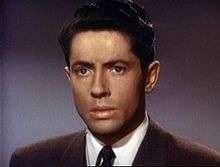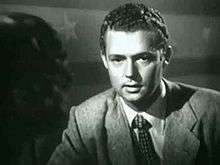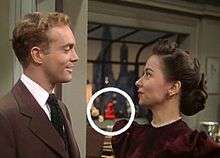Rope (film)
| Rope | |
|---|---|
 Original theatrical poster | |
| Directed by | Alfred Hitchcock |
| Produced by |
Alfred Hitchcock Sidney Bernstein (uncredited) |
| Screenplay by | Arthur Laurents |
| Based on |
Rope by Patrick Hamilton |
| Starring |
James Stewart John Dall Farley Granger Joan Chandler Sir Cedric Hardwicke Constance Collier Douglas Dick Edith Evanson |
| Music by |
|
| Cinematography |
Joseph A. Valentine William V. Skall |
| Edited by | William H. Ziegler |
Production company | |
| Distributed by |
Warner Bros. Pictures (US) Metro-Goldwyn-Mayer (Europe) |
Release dates | August 28, 1948 |
Running time | 80 minutes |
| Country | United States |
| Language | English |
| Budget |
$1.5 million[1] or $2 million[2] |
| Box office | $2.2 million (rentals)[3] |
Rope is a 1948 American psychological crime thriller film directed by Alfred Hitchcock, based on the 1929 play of the same name by Patrick Hamilton, and adapted by Hume Cronyn and Arthur Laurents.[4]
The film was produced by Hitchcock and Sidney Bernstein as the first of their Transatlantic Pictures productions. Starring James Stewart, John Dall and Farley Granger, this is the first of Hitchcock's Technicolor films, and is notable for taking place in real time and being edited so as to appear as a single continuous shot through the use of long takes.[5] It is the second of Hitchcock's "limited setting" films, the first being Lifeboat.[6] The original play was said to be inspired by the real-life murder of 14-year-old Bobby Franks in 1924 by University of Chicago students Nathan Leopold and Richard Loeb.
Plot
Two brilliant young aesthetes, Brandon Shaw (Dall) and Phillip Morgan (Granger), strangle to death their former classmate from Columbia University, David Kentley (Dick Hogan), in their apartment. They commit the crime as an intellectual exercise; they want to prove their superiority by committing the "perfect murder".
After hiding the body in a large antique wooden chest, Brandon and Phillip host a dinner party at the apartment, which has a panoramic view of Manhattan's skyline. The guests, who are unaware of what has happened, include the victim's father Mr. Kentley (Cedric Hardwicke) and aunt Mrs. Atwater (Constance Collier); his mother is not able to attend due to a cold. Also there are his fiancée, Janet Walker (Joan Chandler) and her former lover Kenneth Lawrence (Douglas Dick), who was once David's close friend.

Brandon uses the chest containing the body as a buffet table for the food, just before their housekeeper, Mrs. Wilson (Edith Evanson) arrives to help with the party. "Now the fun begins," Brandon says when the first guests arrive.
Brandon and Phillip's idea for the murder was inspired years earlier by conversations with their prep school housemaster, publisher Rupert Cadell (Stewart). While at school, Rupert had discussed with them, in an apparently approving way, the intellectual concepts of Nietzsche's Übermensch, and De Quincey's art of murder, as a means of showing one's superiority over others. He too is among the guests at the party, since Brandon in particular feels that he would approve of their "work of art".
Brandon's subtle hints about David's absence indirectly lead to a discussion on the "art of murder". Brandon appears calm and in control, although when he first speaks to Rupert he is nervously excited and stammering. Phillip, on the other hand, is visibly upset and morose. He does not conceal it well and starts to drink too much. When David's aunt, Mrs. Atwater, who fancies herself as a fortune-teller, tells him that his hands will bring him great fame, she is referring to his skill at the piano, but he appears to think this refers to the notoriety of being a strangler.
Much of the conversation, however, focuses on David and his strange absence, which worries the guests. A suspicious Rupert quizzes a fidgety Phillip about this and about some of the inconsistencies that have been raised in conversation. For example, Phillip had vehemently denied ever strangling a chicken at the Shaws' farm, but Rupert has personally seen Phillip strangle several. Phillip later complains to Brandon about having had a "rotten evening", not because of David's murder, but over Rupert's questioning.
As the evening goes on, David's father and fiancée begin to worry that he has neither arrived nor phoned. Brandon increases the tension by playing matchmaker between Janet and Kenneth. Mrs. Kentley calls, overwrought because she has not heard from David, and Mr. Kentley decides to leave. He takes with him some books Brandon has given him, tied together with the rope Brandon and Phillip used to strangle his son.
When Rupert goes to leave, Mrs. Wilson accidentally hands him David's monogrammed hat, further arousing his suspicion. Rupert returns to the apartment a short while after everyone else has departed, pretending that he has left his cigarette case behind. He hides the case behind some books on the chest, asks for a drink and then stays to theorize about David's disappearance. He is encouraged by Brandon, who hopes Rupert will understand and even applaud them. A drunk Phillip is unable to take it any more; he throws a glass and says, "Cat and mouse, cat and mouse. But which is the cat and which is the mouse?"
Rupert lifts the lid of the chest and finds the body inside. He is horrified but also deeply ashamed, realizing that Brandon and Phillip used his own rhetoric to rationalize murder. Rupert disavows all his previous talk of superiority and inferiority, realizing that there is no way to objectively define these concepts, then seizes Brandon's gun and fires several shots out the window in order to attract attention. As approaching police sirens get louder, Rupert pulls up a chair next to the chest and the film's end credits appear on the screen.
Cast
 James Stewart as Rupert Cadell, prep-school housemaster and publisher
James Stewart as Rupert Cadell, prep-school housemaster and publisher John Dall as Brandon Shaw, co-murderer and co-host at the party
John Dall as Brandon Shaw, co-murderer and co-host at the party Farley Granger as Phillip Morgan, co-murderer and co-host of the party
Farley Granger as Phillip Morgan, co-murderer and co-host of the party Joan Chandler as Janet Walker, columnist and David's fiancée
Joan Chandler as Janet Walker, columnist and David's fiancée Sir Cedric Hardwicke as Mr. Henry Kentley, David's father
Sir Cedric Hardwicke as Mr. Henry Kentley, David's father
 Constance Collier as Mrs. Anita Atwater, David's aunt
Constance Collier as Mrs. Anita Atwater, David's aunt Douglas Dick as Kenneth Lawrence, David's friend
Douglas Dick as Kenneth Lawrence, David's friend Edith Evanson as Mrs. Wilson, Brandon's housekeeper
Edith Evanson as Mrs. Wilson, Brandon's housekeeper Dick Hogan as David Kentley, the murder victim
Dick Hogan as David Kentley, the murder victim
Production
The film is one of Hitchcock's most experimental and "one of the most interesting experiments ever attempted by a major director working with big box-office names",[7] abandoning many standard film techniques to allow for the long unbroken scenes. Each shot ran continuously for up to ten minutes without interruption. It was shot on a single set, aside from the opening establishing shot street scene under the credits. Camera moves were carefully planned and there was almost no editing.
The walls of the set were on rollers and could silently be moved out of the way to make way for the camera and then replaced when they were to come back into shot. Prop men constantly had to move the furniture and other props out of the way of the large Technicolor camera, and then ensure they were replaced in the correct location. A team of soundmen and camera operators kept the camera and microphones in constant motion, as the actors kept to a carefully choreographed set of cues.[1]
The extraordinary cyclorama in the background was the largest backing ever used on a sound stage.[1] It included models of the Empire State and the Chrysler buildings. Numerous chimneys smoke, lights come on in buildings, neon signs light up, and the sunset slowly unfolds as the movie progresses. Within the course of the film the clouds—made of spun glass—change position and shape eight times.[1]
A camera operator's foot was broken by a heavy dolly during one intensive take, and he was gagged (to stop his vocal noises from being recorded on the film) and hauled out of the studio so that filming could continue without interruption.[8]
Long takes
Hitchcock shot for periods lasting up to 10 minutes (the length of a film camera magazine), continuously panning from actor to actor, though most shots in the film wound up being shorter.[9] Every other segment ends by panning against or tracking into an object—a man's jacket blocking the entire screen, or the back of a piece of furniture, for example. In this way, Hitchcock effectively masked half the cuts in the film.[10]
However, at the end of 20 minutes (two magazines of film make one reel of film on the projector in the movie theater), the projectionist—when the film was shown in theaters—had to change reels. On these changeovers, Hitchcock cuts to a new camera setup, deliberately not disguising the cut. A description of the beginning and end of each segment follows.

| Segment | Length | Time-code | Start | Finish |
|---|---|---|---|---|
| 1 | 09:34 | 00:02:30 | Close-up (CU), strangulation | Blackout on Brandon's back |
| 2 | 07:51 | 00:11:59 | Black, pan off Brandon's back | CU Kenneth: "What do you mean?" |
| 3 | 07:18 | 00:19:45 | Unmasked cut, men crossing to Janet | Blackout on Kenneth's back |
| 4 | 07:08 | 00:27:15 | Black, pan off Kenneth's back | CU Phillip: "That's a lie." |
| 5 | 09:57 | 00:34:34 | Unmasked cut, CU Rupert | Blackout on Brandon's back |
| 6 | 07:33 | 00:44:21 | Black, pan off Brandon's back | Three shot |
| 7 | 07:46 | 00:51:56 | Unmasked cut, Mrs. Wilson: "Excuse me, sir." | Blackout on Brandon |
| 8 | 10:06 | 00:59:44 | Black, pan off Brandon | CU Brandon's hand in gun pocket |
| 9 | 04:37 | 01:09:51 | Unmasked cut, CU Rupert | Blackout on lid of chest |
| 10 | 05:38 | 01:14:35 | Black, pan up from lid of chest | End of film |
Hitchcock told François Truffaut in the book-length Hitchcock/Truffaut (Simon & Schuster, 1967) that he ended up re-shooting the last four or five segments because he was dissatisfied with the color of the sunset.
Hitchcock used this long-take approach again to a lesser extent on his next film, Under Capricorn (1949) and in a very limited way in his film Stage Fright (1950).
Director's cameo

Alfred Hitchcock's cameo is a signature occurrence in most of his films. In this film, Hitchcock is considered to make two appearances,[11] according to Arthur Laurents in the documentary Rope Unleashed, available on the DVD and Blu-ray. Laurents says that Hitchcock is a man walking down a Manhattan street in the opening scene, immediately after the title sequence.
At 55:19 into the film, a red neon sign in the far background showing Hitchcock's profile with "Reduco",[12] the fictitious weight loss product used in his Lifeboat (1944) cameo, starts blinking; as the guests are escorted to the door actors Joan Chandler and Douglas Dick stop to have a few words, the sign appears and disappears in the background several times, right between their visages, right under the eyes of the spectators.
Homosexual subtext
Recent reviews and criticism of Rope claim that the film included a homosexual subtext between the characters Brandon and Phillip,[13][14] even though homosexuality was a highly controversial theme for the 1940s. The movie made it past the Production Code censors; however, during the film's production, those involved described homosexuality as "it".[4] However, many towns chose to ban the film independently, memories of Leopold and Loeb still being fresh in some people's minds.

Reception
In 1947, Variety magazine said "Hitchcock could have chosen a more entertaining subject with which to use the arresting camera and staging technique displayed in Rope."[15] The next year, Bosley Crowther of The New York Times said the "novelty of the picture is not in the drama itself, it being a plainly deliberate and rather thin exercise in suspense, but merely in the method which Mr. Hitchcock has used to stretch the intended tension for the length of the little stunt" for a "story of meager range".[16] Nearly 36 years later, Vincent Canby, also of The New York Times, called the "seldom seen" and "underrated" film "full of the kind of self-conscious epigrams and breezy ripostes that once defined wit and decadence in the Broadway theater"; it's a film "less concerned with the characters and their moral dilemmas than with how they look, sound and move, and with the overall spectacle of how a perfect crime goes wrong".[13]
In the Time magazine 1948 review, the play that the film was based on is called an "intelligent and hideously exciting melodrama" though "in turning it into a movie for mass distribution, much of the edge [is] blunted."[17]
Much of the play's deadly excitement dwelt in [the] juxtaposition of callow brilliance and lavender dandyism with moral idiocy and brutal horror. Much of its intensity came from the shocking change in the teacher, once he learned what was going on. In the movie, the boys and their teacher are shrewdly plausible but much more conventional types. Even so, the basic idea is so good and, in its diluted way, Rope is so well done that it makes a rattling good melodrama.
Roger Ebert wrote in 1984, "Alfred Hitchcock called Rope an 'experiment that didn’t work out', and he was happy to see it kept out of release for most of three decades," but went on to say that "Rope remains one of the most interesting experiments ever attempted by a major director working with big box-office names, and it's worth seeing [...]."[7]
A 2001 BBC review of that year's DVD release called the film "technically and socially bold" and pointed out that given "how primitive the Technicolor process was back then", the DVD's image quality is "by those standards quite astonishing"; the release's "2.0 mono mix" was clear and reasonably strong, though "distortion creeps into the music".[18]
In his article "Remembering When", Antonio Damasio argues that the time frame covered by the movie, which lasts 80 minutes and is supposed to be in "real time", is actually longer—a little more than 100 minutes.[19] This, he states, is accomplished by speeding up the action: the formal dinner lasts only 20 minutes, the sun sets too quickly and so on.
See also
- Compulsion, a 1959 film based on the Leopold and Loeb events.
- Psychoville, a 2009 BBC2 comedy series. Episode four of the series is a deliberate two-take pastiche of Rope.
- R.S.V.P., a 2002 film that borrowed several key elements from Rope, and in which the film is discussed.
- Swoon, an independent 1992 film by Tom Kalin depicting the actual Leopold and Loeb events.
- In Rake Season 2, episode 3, 'Woolridge and Anor' the film is seen as an influence for a murder by two school girls.
Notes
- 1 2 3 4 Truffaut, François (1967). Hitchcock/Truffaut. New York: Simon & Schuster.
- ↑ Variety, 18 February 1948, pg 14.
- ↑ "Top Grossers of 1948". Variety, 5 January 1949, pg 46.
- 1 2 Rope Unleashed – Making Of (2000) – documentary on the Universal Studios DVD of the film.
- ↑ The AFI Catalog of Feature Films:Rope
- ↑
- 1 2 Ebert, Roger. "Rope". Chicago Sun-Times. Retrieved November 8, 2008.
- ↑ IMDb: Rope
- ↑ Jacobs, Steven (2007). The Wrong House: The Architecture of Alfred Hitchcock. p. 272.
- ↑ https://archive.org/stream/variety169-1948-03#page/n73/mode/1up
- ↑ Interview with Arthur Laurents in the making-of documentary, Rope Unleashed.
- ↑ Gottlieb, Sidney: Hitchcock on Hitchcock. Faber and Faber, 1995. p282.
- 1 2 Canby, Vincent (3 June 1984). "Hitchcock's 'Rope:' A Stunt to Behold". The New York Times. Retrieved 2009-05-14.
- ↑ Miller, D. A. "Anal Rope" in Inside/Out: Lesbian Theories, Gay Theories, pp. 119–141. Routledge, 1991. ISBN 0-415-90237-1
- ↑ 1947 Review of Rope from Variety
- ↑ Crowther, Bosley (17 August 1948). "'Rope': An Exercise in Suspense Directed by Alfred Hitchcock". The New York Times. Retrieved 2009-05-14.
- ↑ "The New Pictures". Time. 13 September 1948. Retrieved 2009-05-14.
- ↑ Haflidason, Almar (18 June 2001). "Rope DVD (1948)". BBC. Retrieved 2009-05-14.
- ↑ Damasio, Antonio. "Remembering When" in Scientific American, 2002.
References
- Neimi, Robert (2006). History in the Media: Film and Television. ABC-CLIO. ISBN 1-57607-952-X.
Further reading
- Wollen, Peter. Rope: Three Hypotheses. Alfred Hitchcock Centenary Essays.
- Miller, D. A. 'Anal Rope.' Representations 32 (Aut. 1990): 114-133.
External links
| Wikimedia Commons has media related to: |
| Wikiquote has quotations related to: Rope (film) |
- Rope at the Internet Movie Database
- Rope at the TCM Movie Database
- Rope at AllMovie
- Rope at Rotten Tomatoes
- Trailer for Rope